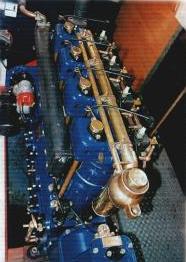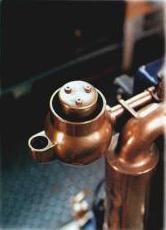movers & shakers
In the first of an occasional series ANDREW TALBOT looks at the Kelvin diesel engine
 |
|
Brass Inlet Valve levers sticking up next to the sparking plugs on Mike Skyner's Kelvin. The chain winds the reverse clutches into engagement. |
Whether you're a towpath walker, an occasional hire boater, or the proud owner of a boat with an unseen modern diesel, you may have wondered about the slow and rhythmic thump, sometimes heard and sometimes only felt, emanating from that passing boat. You may have wondered about the shining brass and green, or grey, or burgundy, or blue, or other hued monsters fleetingly visible through open engine room doors. Wondered about the smoke rings blowing from the exhaust in the cabin roof.
This series of articles will introduce you to some of the inhabitants of those scumbled, brass bound, glorious engine rooms and try to explain the passions and partialities that exist in equal measure, for makes and models that their opponents decry.
An alphabetical list would quell any feeling that there was an expressed preference on the part of this magazine for any one make, but things don't necessarily work out the way one wants, so the order in which the engines appear is random. No preference expressed or implied!
The idea for these articles arrived in a quiet corner of my brain last summer end at Whitchurch rally. Walking the towpath and looking through engine room doors I saw a gleaming brass and blue Kelvin. The owner was setting off down the towpath with an armful of beer cans so I guessed the time wasn't quite right for a chat. However, I did begin to think that there might be others who wanted to know what it was like to live with an engine that inhabits more space than the humans do in my small boat.
A trip around the Internet and into the advertising pages of Waterways World followed by some phone calls, and a picture began to form of what enthusiasms exist for these engines. Kevin Whittle, famous amongst classic boat engines, gave me Dick Goble's phone number. He in turn, who is amongst other things another professional Kelvin fixer, introduced me to Mike Skyner.
 |
|
The starboard side of the engine. Water pump
at the front, fuel pump in the centre with the governor behind it.
|
Mike has a 55ft Josher replica, Pangur Bán (White Cat in Gaelic), built at Roger Fullers' Five Towns Boatbuilding at Stone, and was enthusiastic about my photographing his Kelvin J4. Meeting Mike was rather like digging the garden and striking oil. His Internet web site is recognised as the "unofficial" Kelvin web site and having rebuilt his engine from a pile of bits he knows what's what.
Kelvin's Story
In 1906 Walter and Willie Bergius of Glasgow installed one of their four-cylinder, 12 hp, motor car engines in a 23 ft rowing gig, the Kelvin. This was entered in motor boat races and was so successful that the Bergius Car & Engine Company had soon changed over to marine engine production and called itself by the name of its successful racing gig. A 7 hp Kelvin engine was first fitted to a Scottish fishing boat, The Brothers of Campbeltown, in 1907. Kelvin produced a scheme which allowed the boat owner to pay half the cost of the new engine and installation and, because the boats could now go further and faster, with or without the wind, pay off the rest with the profits from improved catches.
Kelvins were never originally fitted to narrowboats, but have found a solid band of enthusiasts who love to have their boats driven by a unique engineering design. Perhaps the most unusual part of the Kelvin was its ability, in the days of unreliable batteries, to hand start on petrol and change over onto diesel when warmed up. The spark ignition is provided by a magneto, which needs no battery.
To call this engine a monster is to do it an injustice. It certainly is big. At five feet long, there is just room to get round it in the eight foot engine room. It's heavy, although at 17cwt not as heavy as some and it's cubic capacity at 6 litres, is bigger by half than the biggest Jaguar V12. Each cylinder is bigger than the entire engine of your average hatchback. Whilst nothing could be described as delicate, the Kelvin exudes refinement too. It only holds a gallon of oil in its sump whereas some of its contemporaries need a five-gallon drum for an oil change. Many of its components show engineering finesse. Brass castings are fine but functional. The engine governor is a modest masterpiece.
 |
|
The Governor
|
If pressed the J4 would reach a thundering 1000rpm, although its usual gait is about 450rpm. It's designed to idle at 230 rpm all day. As far as power is concerned it's necessary to know that Horse Power has two components, Revolutions per minute and Torque. Although lacking RPM the Kelvin's 44 shaft horsepower is mightily endowed with torque; around 300 lbs/ft of it. Comparing that with what your car engine produces will give an idea of how powerful the Kelvin is. With no reduction gearbox, reverse being provided by a cone clutch, the Kelvin swings a 22 X 19 inch prop. So powerful is this combination that, whilst running the engine for us, Mike engaged forward gear at idle and from a distance of no more than a foot rammed the dock wall. The impact caused one of his beloved ribbon plates to leap off its peg and smash to the floor! The boat apparently stops well too. In one or two close shaves Mike's boat was going backwards whilst the approaching speed merchant was still trying to slow down.
Mike's engine, number 18506, was built in 1934 and started life as the starboard one of a pair in a riverboat called Wanderer ll. Rebuilding it with new cylinder and head castings gave Mike an enviable insight into the construction and running of this fine engine. He will point out, by way of a test of your ability to think laterally, that this is the only engine that has a sump oil level that goes up. Instead of topping the oil up, you have, from time to time, to pump some out! No, I couldn't work it out either. The answer is that the rocker gear is lubricated from brass-capped wells, which have to be topped up regularly, and the oil from these goes into the sump!
 |
|
The red cap of the magneto at top left with
the brass inlet manifold across the top of the engine.
|
Not an engine for those of us who open the engine covers once a season, oil circulation is checked, not with a gauge, but by opening a dainty brass tap on the port side of the engine. The water pump oil level and the governor oil level have to be maintained too, although the latter uses diesel oil spilled from the injectors when the engine is started and is running on petrol. The governor overflows into a bottle. Yes, Kelvin even supplied a bracket specially designed to take a Teacher's whiskey bottle! Marketing, research and customer care was active in 1934!
 |
|
Not a teapot, a carburettor!
|
Just in case you fancy something even larger; amongst a range of engines that begins with the J2, 3 litre twin cylinder and progresses through three, to four cylinders, Kelvin produced the K range which powered boats and air compressors for lighthouse foghorns. These are large by any standards at 4 litres per cylinder. So, if you have a big enough boat and enough money, you could be the master of a 6 cylinder, 24 litre monster, 9ft long, 6ft 6in high, weighing around 3 tons and producing 132 hp at 750 rpm but, nevertheless, willing to idle at 160 rpm. But not on the narrow canals!